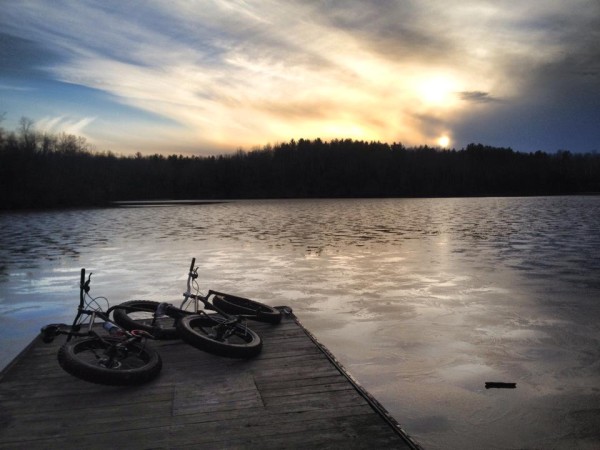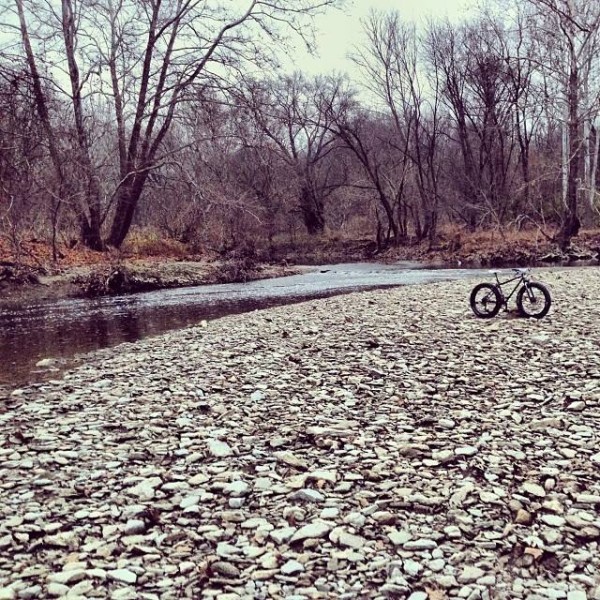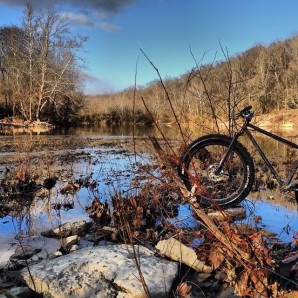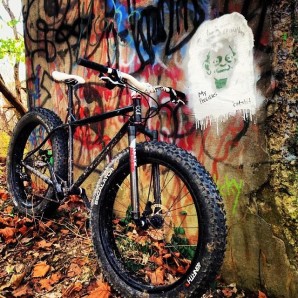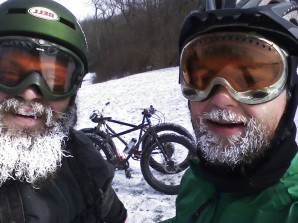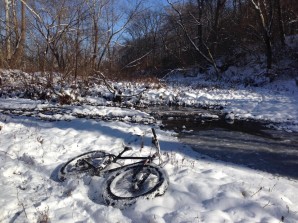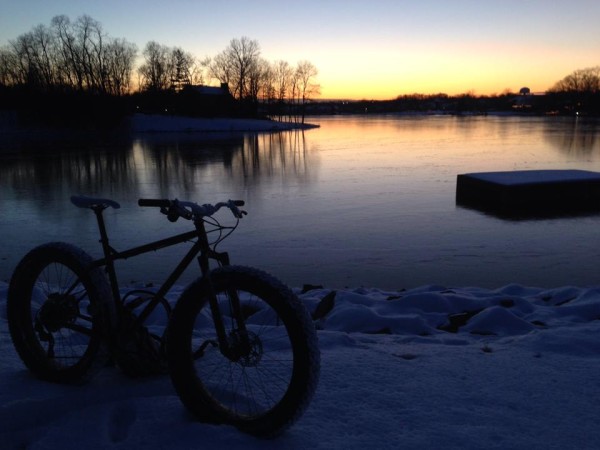Currently it’s -8 degrees, dark, my ice beard from an earlier ride has melted away in front of the fire, and yet I’m sitting here having to force myself from going back outside to ride my fatbike. Crazy? Maybe. Fun? Definitely.
Over the past few months or even years fatbike popularity has skyrocketed. More and more fatbikes and fatbike brands are springing up which seems only to stoke the fire of the fatbike detractors. Whatever the reason, for each person with a resultant permagrin from trundling over permafrost, there is opposition wanting to claim that fatbikes are silly and unnecessary. I’ve been thinking this piece over again and again, and I’m finally ready to say it – fatbikes rock.
After years of pedaling around the bikes with the clown sized tires, one thing is clear – while not for everyone, fatbikes aren’t just a passing fad. If you can’t come to grips with that, well, you might be doing it wrong.
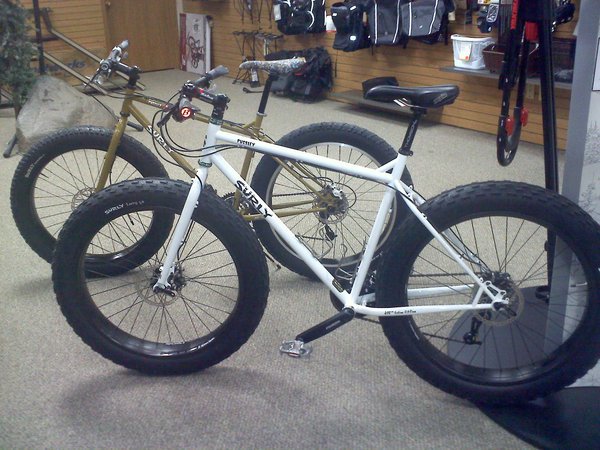
The Beginning
I’m sure I’m not alone here, but when I was younger, the best thing to happen over winter was the occasional snow day. No school? Time to don the snow pants and mittens and take to the snow. Snowball fights. Building snow forts. Exploring frozen forests and creeks. Snow days meant freedom to explore the winter wonderland that was outside the frosted window panes.
I haven’t really outgrown that.
Sure, there are less snowball fights, and very rarely do I have the time to build a snow fort, but that sense of wonder accompanied with the desire to explore has never gone away. For years I rode in the snow with a standard mountain bike which is entirely possible. No one ever said you can’t ride in the snow with a mountain bike, or hell, even a cross bike, but a fatbike changes things.
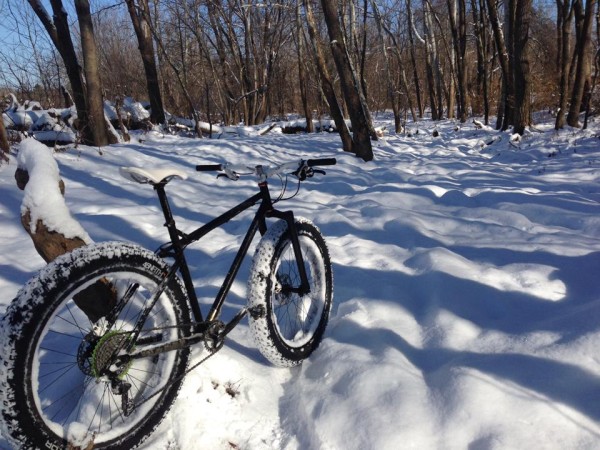
The equipment
So many people think that a fatbike is just a mountain bike with wider tires, but there’s more to it than that.
There comes a point with a normal mountain bike in the snow that you end up carrying or pushing your bike more than riding it. Deep snow, fluffy snow, even ice are much more easily dealt with when you have 4” wide rubber underneath you. In addition to the width, running 3-10 psi in those gargantuan tires allows the tread to envelop large rocks, roots, and other obstacles where a normal mountain bike tire may simply bounce or slide off. Studded tires are not exclusive to fatbikes, but when added to a 4” tire, the added contact patch can mean big gains in traction.
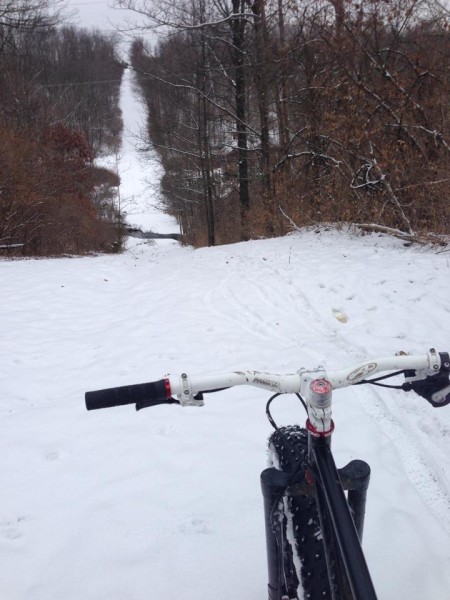
Then there is the bike itself, specifically, how it deals with the elements. With the introduction of $5k+ fatbikes this is probably less applicable, but one of my favorite things about owning a fatbike is that I can ride during the winter and not worry about the road salt, slush, grime, mud, and water from ruining my expensive mountain bikes. A simple steel Surly Pugsley treated with Frame Saver will last a long time in winter conditions without much maintenance. A full suspension mountain bike? Probably not. Since purchasing a fatbike, my winter riding has doubled if not tripled.
Winter fatbiking does mean you’ll need additional gear and clothing, but if you plan to ride any bike over the winter, you’ll need it anyways. And while a fatbike does require a number of pricey fatbike specific parts, there are quite a few parts like bars, stems, seat posts, drive trains, some cranks, etc. that can be used to build up fatbikes on a budget – something a number of riders have done locally. One thing that I have definitely learned though – on a fatbike tires count, big time. Maybe even more so than your average bike. A high TPI tire means much lighter weight and an increasingly supple ride, after all the 4″ tire is basically your suspension. It’s easy to want to cheap out when it comes to super expensive fatbike tires, but trust me, money here is money well spent.
The exploration
The benefits in equipment are obvious. It’s the mindset that takes more explanation. Even after riding fatbikes for years, I still didn’t quite get it.
Sure, it’s nearly impossible to ride a fatbike and not come away with a huge shit eating grin on your face, but some of that is likely due to novelty. Eventually the novelty will wear off, but by then you will probably understand.
Somewhere along the way to “adulthood” my sense of exploration and adventure was somewhat muted. Riding meant visiting the same trails over and over, seeing how fast I could make it to the end. Sure, road riding helped feed that sense of adventure, but there’s something so good about being deep in the wilderness. Fatbiking offered something different.
After a photo from some fatbike loving friends inspired me, I ended up exploring areas right by my house that I have ridden by countless times. Riding through mud bogs, across rivers, over downed trees and across floodwater ravaged fields, my fatbike took me to places I had never been. All of a sudden, I was looking for new lands to explore – some possible to ride on a normal mountain bike, but mostly not. Thanks to the go anywhere, ride over anything capabilities of my Pugsley, suddenly there were so many new places to explore in an area that previously had become old hat.
There are a number of areas locally that are not off limit to bikes, but since there are no real “trails,” people don’t really ride there. The fatbike changes that.
Takeaway
Honestly, I’ll probably never ride some grueling adventure in Alaska, or bike to the South Pole, but my fatbike isn’t going anywhere. Fatbiking offers a change of pace and scenery over the winter that for me, can’t be replaced. Owning a fatbike means never having to wonder if the conditions are right – on a fatbike they are always right*.
I think one of the biggest misconceptions with fatbikes is that on a normal mountain bike you can ride almost as much as you can on a fatbike. That’s true to a point, but take a recent night ride I was on – two of us were on fat bikes, and the other was on a typical mountain bike. The two fatbikes had already done a few laps so the snow was packing in nicely, and yet the third rider on the mountain bike was having a hell of a time trying to keep forward momentum, and after 3/4 of a lap was ready to bail. He was able to ride the trail, but he wasn’t having much fun doing so and in turn rode about 1/3rd as much as the fatbike riders. Knowing the fatbike has very few limitations helps get you out of the house in the winter. Nothing can slow you down.
Riders that live in areas with decent skiing or other winter sport opportunities may have a hard time justifying a fatbike, but there’s a lot of us who simply don’t have those options. There is also something to be said about the solitude you can find out on the trails during the winter. Of course, then there’s the whole mud/sand prowess of the fatbike which makes it more than just a “one season” bike, but that’s a story for another time. There are plenty of people that are perfectly happy to sweat away on their rollers or trainers over the winter, but I’d rather ride anything outside over that. And the fatbike is more than just anything. It is a purpose built fun machine that can take you anywhere you want to go.
Don’t agree? That’s fine with me – you can find me out on my fatbike.
*Fine print – just because a fatbike can ride anywhere, anytime, does not mean that they won’t cause damage to mountain bike trails if ridden when extremely wet. Obey local trail closures just as you would on a normal mountain bike. The mud bogs, swamps, etc I have ridden are in areas approved for use when wet, not on local mountain bike trails.
